Struggling to find the perfect spot for your air fryer in your kitchen? Look no further! Discover the ideal placement for your air fryer, ensuring easy access to healthier, crispier meals while keeping your kitchen neat and organized. Let’s begin!

Air fryer, the innovative kitchen appliance, has transformed the way we cook our favorite meals. They are getting a lot of attention because they provide a healthier way to cook food than traditional frying methods. However, with limited countertop space and various kitchen layouts, finding the ideal storage spot for your air fryer can be quite challenging.
I’ve been thinking about where to put my air fryer in the kitchen. So, I tried different options to see what works best. Now, I want to share all these cool ideas with you, so you can find the perfect spot for your air fryer.
In this article, I’ll share practical insights and solutions to help you decide where to store air fryer, ensuring both functionalities and looks in your kitchen. We’ll explore options like putting it on the counter, hiding it in cabinets, and more. Let’s see which one fits your kitchen and lifestyle the best!
Factors to Consider When Choosing a Location for Your Air Fryer
When you’re deciding where to put your air fryer in the kitchen, there are a few things you should think about:
Size of Your Air Fryer:
First, consider how big your air fryer is. You need to make sure you have enough space wherever you decide to put it. Check the measurements of your air fryer and then measure the space where you want to place it.
Kitchen Layout and Design:
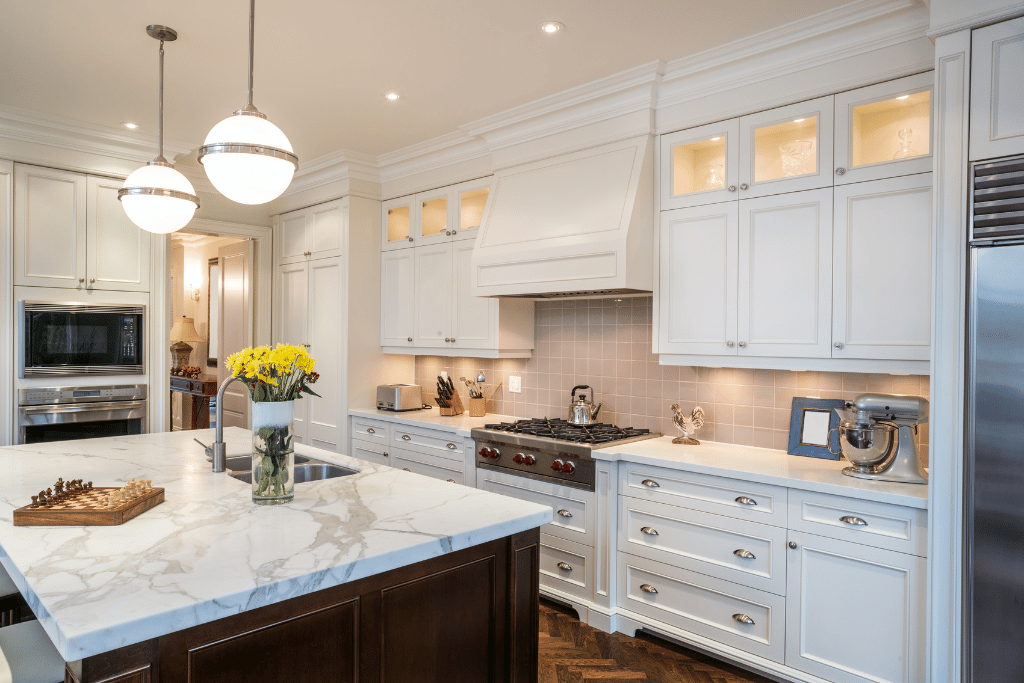
Look at how your kitchen is set up. Think about where you spend the most time cooking and where it would be easiest to reach your air fryer. You want it to be in a convenient spot where you can easily access it while cooking.
Available Storage:
Consider the storage options in your kitchen. Do you have enough space in your cabinets or on your countertop to keep your air fryer? Think about where it will fit best without crowding your kitchen.
Electrical Outlet Availability:
Your air fryer needs to be plugged in while you use it, so make sure there’s an electrical outlet nearby wherever you decide to put it. You don’t want to have to stretch the cord across the kitchen every time you want to use it.
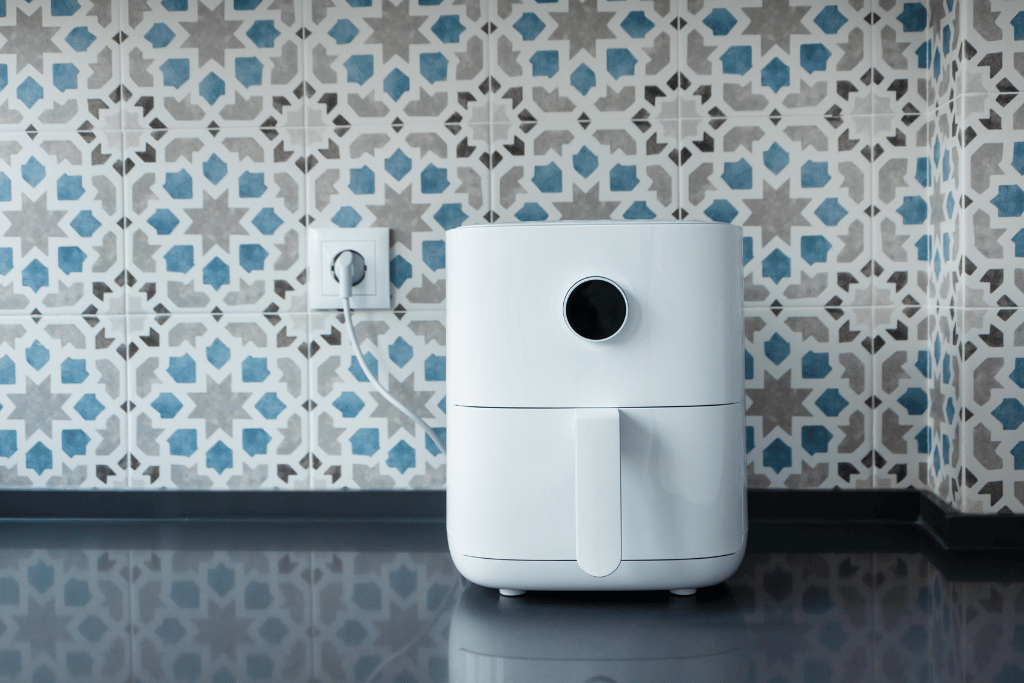
Space When In Use:
Think about how much space you’ll need around your air fryer when you’re using it. You want to make sure there’s enough room for the hot air to circulate and for you to access the basket easily.
Ventilation and Heat Dissipation:
Air fryers produce heat while they’re in use, so it’s important to consider ventilation and heat dissipation. Make sure there’s enough space around your air fryer for the heat to escape and that it’s not too close to anything that could be damaged by heat.
Possible Locations for Your Air Fryer – Including Pros and Cons
Choosing the right location for your air fryer involves weighing various factors, including space availability, convenience, and aesthetics. Here’s a detailed exploration of potential locations along with their respective pros and cons:
1. Worktop/Countertop Placement
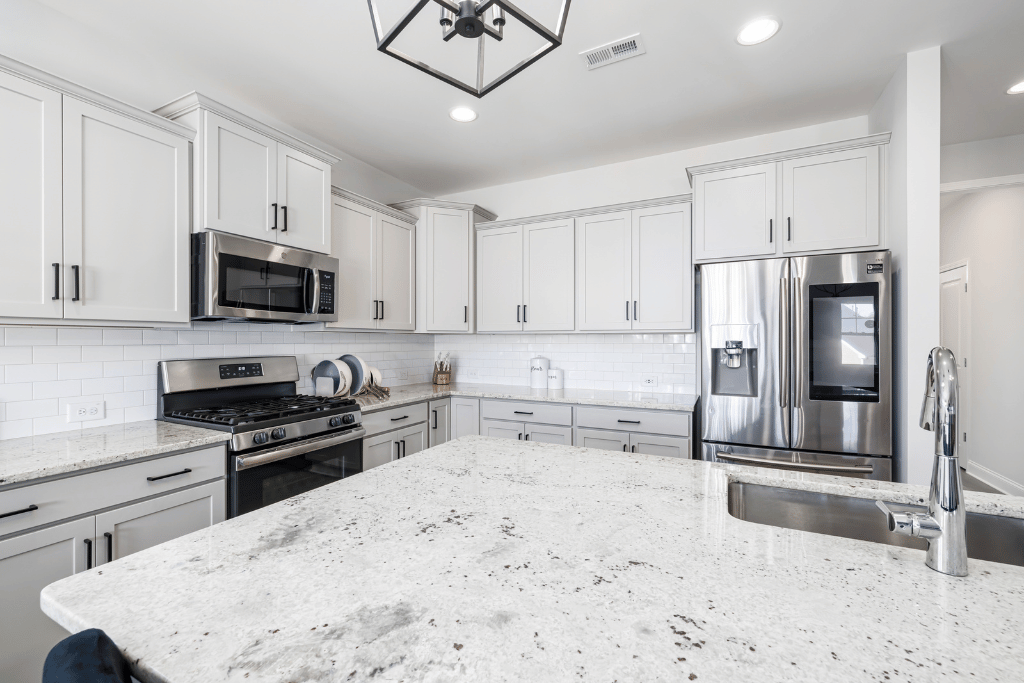
Pros:
- Convenience: Placing the air fryer on the countertop provides easy access for daily use, eliminating the need to retrieve it from storage.
- Visibility: Keeping the air fryer on the countertop makes it readily visible, serving as a reminder to incorporate air frying into your cooking routine.
- Minimal Setup: With countertop placement, there’s no need to rearrange cabinets or drawers, making it a straightforward storage option.
Cons:
- Limited Space: Countertop space is precious in most kitchens, and dedicating a portion of it to the air fryer may lead to overcrowding.
- Cluttered Appearance: Depending on the size of the air fryer and other kitchen appliances, countertop placement can contribute to a cluttered look, especially in smaller kitchens.
- Exposure to Elements: Placing the air fryer on the countertop exposes it to potential spills, splatters, and heat from nearby cooking activities, which may affect its longevity.
2. Kitchen Island
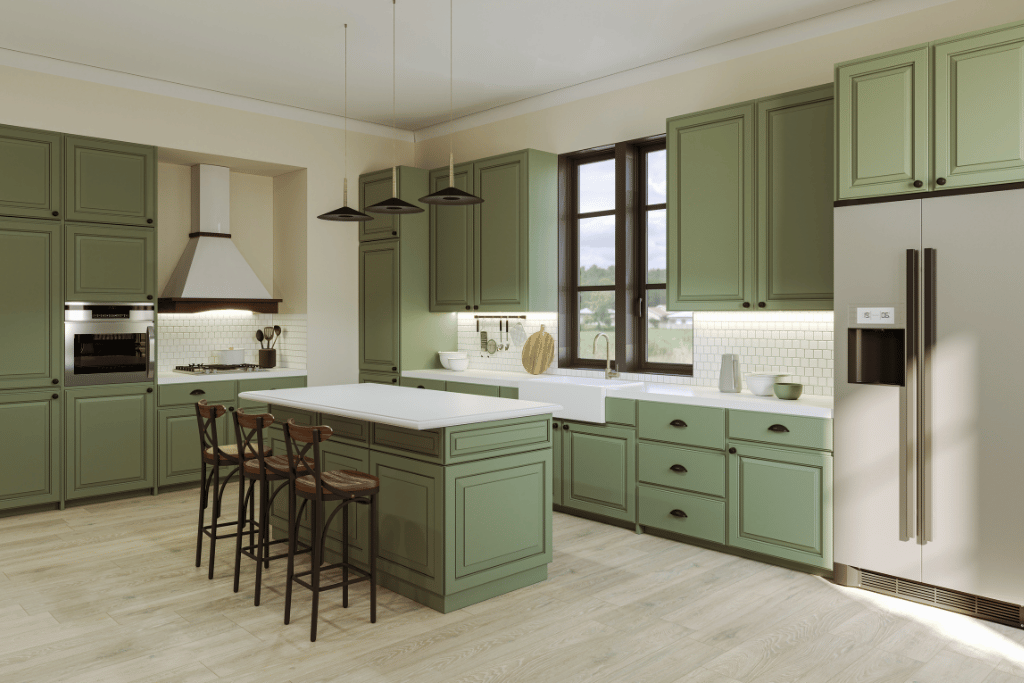
Pros:
- Central Location: Kitchen islands serve as focal points in many kitchens, offering a central location for the air fryer that is easily accessible from various cooking stations.
- Additional Storage: Some kitchen islands feature built-in cabinets or drawers, providing convenient storage space for the air fryer and its accessories.
- Enhanced Workflow: Placing the air fryer on the kitchen island streamlines the cooking process by keeping it within reach during meal preparation.
Cons:
- Limited Space: Depending on the size of the kitchen island and other items occupying it, there may be limited space available for the air fryer.
- Aesthetic Considerations: The presence of the air fryer on the kitchen island may disrupt the aesthetic appeal of the space, especially if it clashes with the island’s design or decor.
- Traffic Flow: Placing the air fryer on the kitchen island may interfere with the flow of traffic in the kitchen, particularly if the island is used for food prep or socializing.
3. Inside a Cabinet or Drawer
Pros:
- Clutter-Free Appearance: Storing the air fryer inside a cabinet or drawer keeps it out of sight when not in use, contributing to a clean and organized kitchen aesthetic.
- Protection from Elements: Cabinets and drawers provide protection from spills, splatters, and other kitchen hazards that could potentially damage the air fryer.
- Maximized Space: Utilizing cabinet or drawer space for air fryer storage frees up valuable countertop real estate for other kitchen activities.
Cons:
- Limited Accessibility: Retrieving the air fryer from inside a cabinet or drawer may require bending or kneeling, which can be inconvenient, especially for individuals with mobility issues.
- Space Constraints: Cabinets and drawers have limited capacity, and accommodating the air fryer alongside other kitchen essentials may be challenging in smaller kitchens.
- Ventilation Concerns: Ensure that the cabinet or drawer has adequate ventilation to prevent heat buildup when storing the air fryer after use.
4. In the Pantry
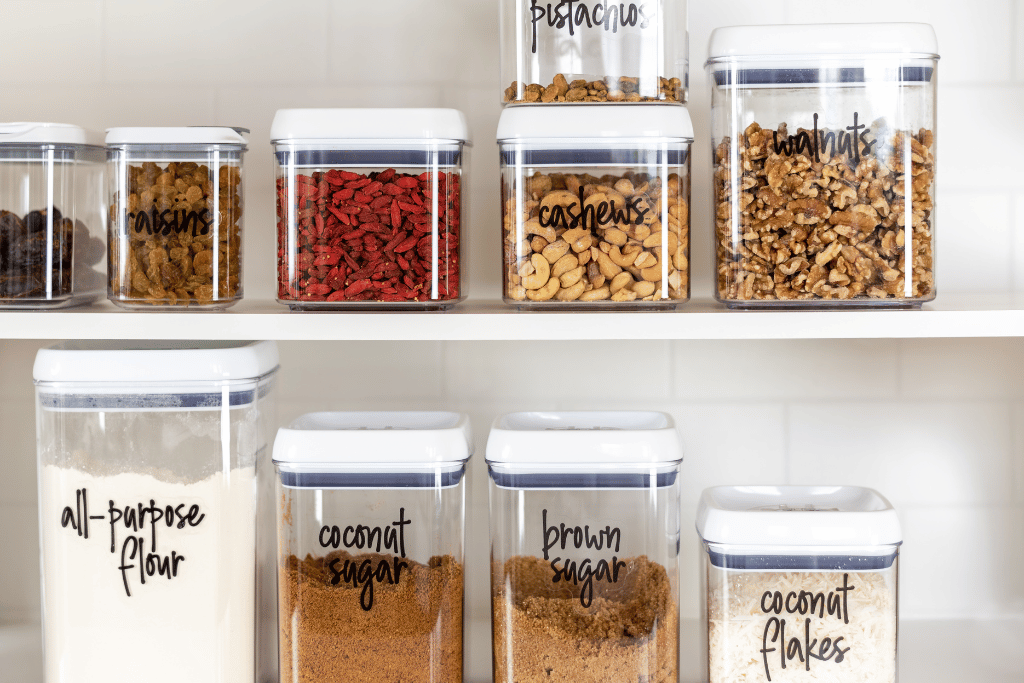
Pros:
- Hidden Storage: Storing the air fryer in the pantry keeps it concealed from view, maintaining a tidy and uncluttered kitchen environment.
- Preserved Countertop Space: By relocating the air fryer to the pantry, you can free up valuable countertop space for food preparation and other kitchen activities.
- Protected Storage: Pantries provide a controlled environment free from exposure to heat, moisture, and other elements that could potentially damage the air fryer.
Cons:
- Out of Sight, Out of Mind: Storing the air fryer in the pantry may lead to decreased usage if it’s not easily accessible or visible, potentially relegating it to the realm of forgotten appliances.
- Limited Accessibility: Retrieving the air fryer from the pantry may require navigating through shelves and other stored items, which can be cumbersome, especially during meal preparation.
- Space Constraints: Pantries vary in size and layout, and accommodating the air fryer alongside other pantry essentials may be challenging in smaller or poorly organized spaces.
5. Consider Placing It on a Rolling Cart
Pros:
- Mobility: Rolling carts offer the flexibility to move the air fryer to different locations within the kitchen or dining area as needed, providing convenience during meal preparation and serving.
- Additional Storage: Some rolling carts feature built-in shelves or baskets, providing additional storage space for air fryer accessories, cookbooks, and other kitchen essentials.
- Versatility: Rolling carts can serve multiple purposes beyond air fryer storage, such as a portable serving station or a mobile kitchen island, enhancing the functionality of your kitchen space.
Cons:
- Floor Space Requirements: Rolling carts require dedicated floor space in the kitchen or dining area, which may be limited in smaller or tightly configured spaces.
- Stability Concerns: Depending on the design and construction of the rolling cart, there may be concerns about stability and safety, particularly if the air fryer is placed on an uneven surface or overloaded with weight.
- Aesthetic Considerations: The presence of a rolling cart in the kitchen may disrupt the overall aesthetic cohesion of the space, especially if it clashes with existing decor or design elements.
Safety and Convenience
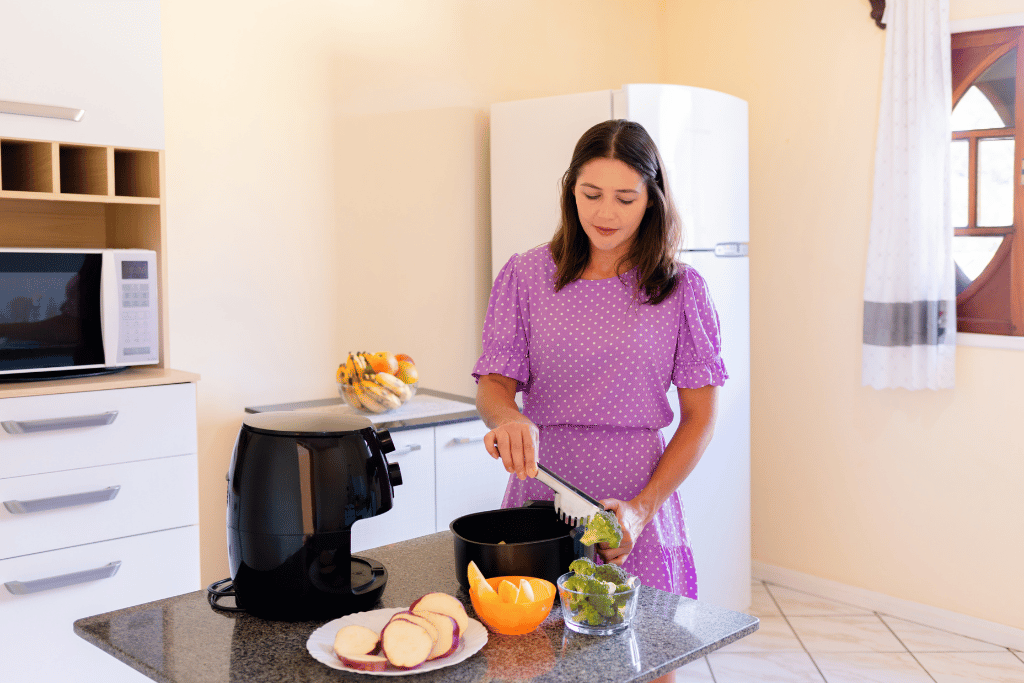
When it comes to kitchen appliances like the air fryer, finding the right spot for storage is crucial for both safety and convenience. Whether you’re actively using your air fryer or stowing it away during periods of non-use, following proper guidelines ensures longevity and ease of access.
Where to Place Air Fryer When In Use:
- Ventilation Space: The air fryer requires proper ventilation during operation. Avoid storing it in enclosed spaces or under cabinets that might restrict airflow. Placing it on a heat-resistant surface is advisable to prevent any damage.
- Stable Surface: Ensure that the surface you place the air fryer on is stable and level. This prevents accidental tipping or spilling, especially when dealing with hot surfaces and oils.
- Accessible Location: Opt for a location where the air fryer is easily accessible. This facilitates hassle-free cooking and reduces the risk of accidents caused by reaching over obstacles or handling hot appliances in awkward positions.
- Away from Water Sources: Keep the air fryer away from water sources or areas prone to moisture accumulation to prevent electrical hazards. A dry environment is essential for safe operation.
- Monitor During Operation: Keep an eye on your air fryer while it’s in use, especially if you’re cooking at high temperatures. Be mindful of any unusual smells, smoke, or noises, and immediately turn off the air fryer if you notice any issues.
- Follow Manufacturer’s Instructions: Always follow the manufacturer’s instructions and guidelines for safe operation of your air fryer. This includes proper assembly, usage, and maintenance procedures to ensure safety and longevity.
Where to Store Air Fryer When Not In Use:
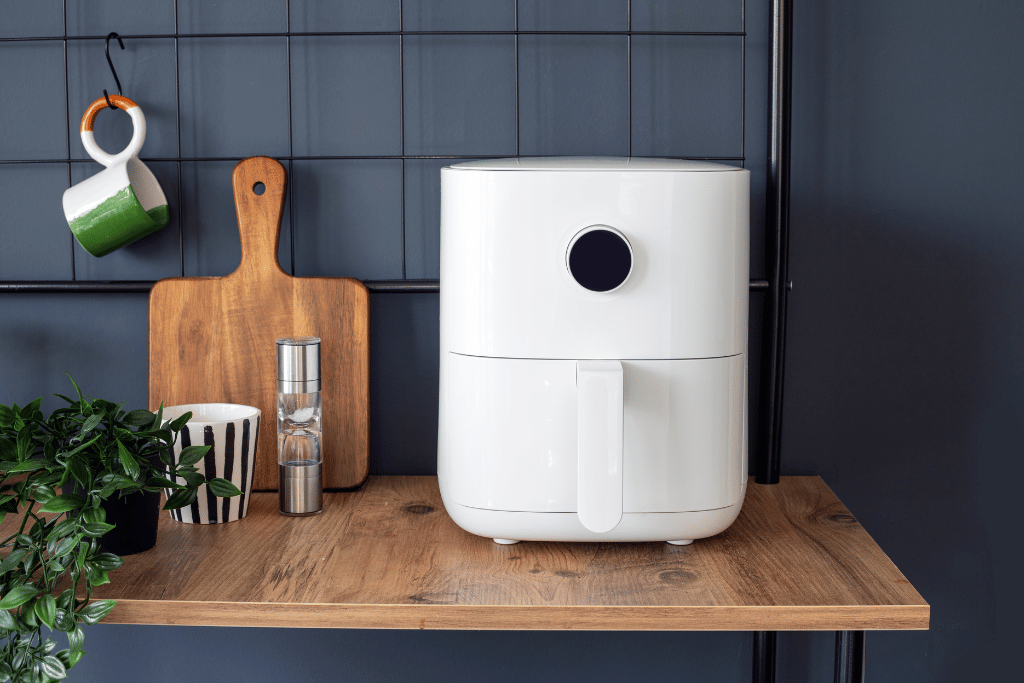
- Unplug When Not in Use: Always unplug your air fryer from the electrical outlet when it’s not in use. This not only saves energy but also reduces the risk of electrical hazards.
- Cooling Down Period: Allow the air fryer to cool down completely before storing it away. This prevents the risk of burns and ensures that internal components are not subjected to unnecessary heat stress.
- Cleaning Routine: Develop a regular cleaning routine to maintain hygiene and prolong the lifespan of your air fryer. Remove any food residue or grease buildup, both inside and outside the appliance, before storage.
- Cord Management: Properly coil and secure the power cord to prevent tripping hazards and damage. Some air fryer models come with built-in cord storage features for added convenience.
- Cover or Enclosure: Consider using a cover or enclosure specifically designed for air fryers to protect them from dust and potential damage when not in use. Alternatively, a clean cloth or towel can serve as a temporary cover.
- Storage Space: Choose a storage location that is dry, cool, and free from extreme temperatures. Avoid storing the air fryer near sources of heat or direct sunlight, as these conditions can affect its performance and longevity.
- Check for Damage: Periodically inspect your air fryer for any signs of damage, such as frayed cords or cracked components. If you notice any issues, refrain from using the appliance and seek professional assistance for repairs.
Locations to Avoid Storing Your Air Fryer
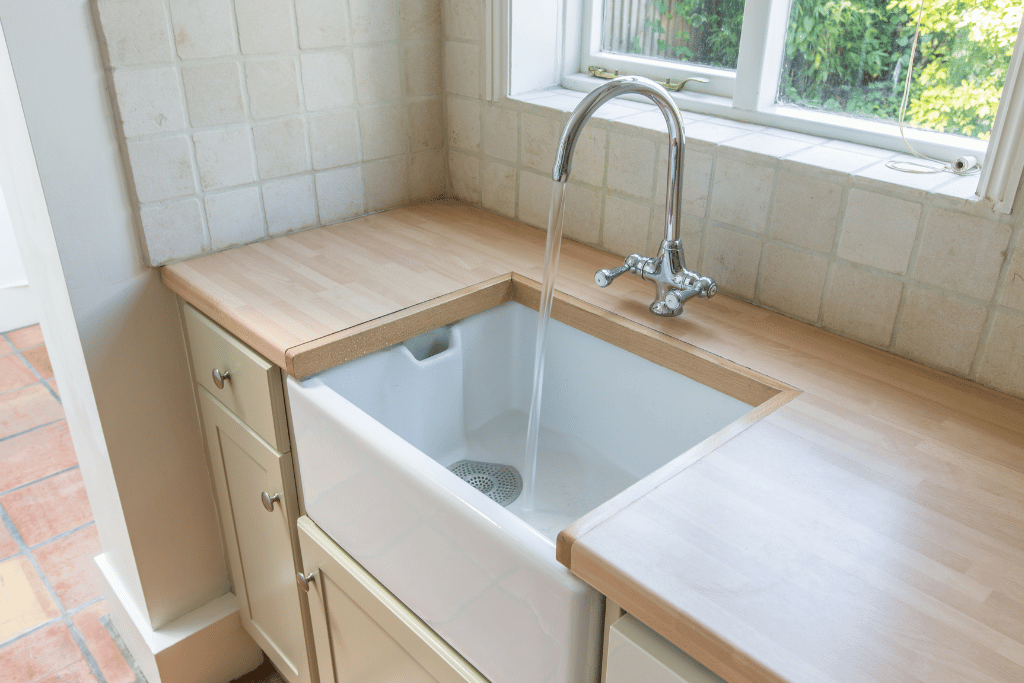
While it’s essential to find a suitable spot for your air fryer in the kitchen, there are some places you should avoid storing it. Here are a few places you should never store your air fryer:
- Over the Stove: Storing your air fryer directly above the stove can expose it to heat, steam, and grease splatters, which can damage the appliance and affect its performance. Additionally, the heat from the stove can pose a fire hazard.
- Inside the Oven: Placing your air fryer inside the oven, especially while it’s in use, is not recommended. The intense heat generated inside the oven can damage the air fryer and its components.
- Near Water Sources: Avoid storing your air fryer near sinks, dishwashers, or other water sources where it could be splashed or exposed to moisture. Water and electrical appliances don’t mix well and can lead to safety hazards.
- Direct Sunlight Exposure: Keep your air fryer away from direct sunlight, as prolonged exposure to sunlight can cause discoloration, warping, and damage to the appliance’s exterior.
- Unstable Surfaces: Avoid placing your air fryer on unstable surfaces such as wobbly countertops or uneven tables. An unstable surface can cause the air fryer to tip over, leading to accidents and damage.
Can You Put an Air Fryer Under the Cabinet?
Putting an air fryer under a cabinet can pose risks and is generally not recommended. Air fryers require adequate ventilation during operation to prevent overheating and ensure safe usage. Placing an air fryer under a cabinet may restrict airflow, leading to heat buildup and potentially causing damage to the cabinet or the air fryer itself.
Additionally, the heat generated by the air fryer needs space to dissipate safely. If placed too close to a cabinet, the heat can damage the cabinet surface or even pose a fire hazard, especially if the cabinet material is not heat-resistant.
To ensure safety and optimal performance, it’s best to place your air fryer on a stable, heat-resistant surface with sufficient clearance on all sides, including above. This allows proper airflow and minimizes the risk of accidents or damage to surrounding surfaces.
If cabinet space is limited, consider finding an alternative location for your air fryer that provides adequate ventilation and clearance. Investing in a kitchen cart or designated countertop space can offer a convenient and safe solution for storing and using your air fryer without compromising safety or risking damage to your cabinets.
Conclusion
Deciding where to store air fryer is important for making your kitchen work well. Factors such as its size, accessibility, and safety should be considered. Whether you opt to place your air fryer on the countertop for convenient access during meal preparation, inside a cabinet or drawer for a neat appearance, or in the pantry for concealed storage, each choice presents its advantages and drawbacks.
By carefully evaluating the pros and cons of each potential location and assessing how it aligns with your lifestyle and cooking preferences, you can make a well-informed decision that enhances both practicality and visual appeal in your kitchen.
No matter where you decide to put it, think about what works best for you. Consider what’s easy, safe, and looks good in your kitchen. Your air fryer should be in a spot that makes cooking fun and easy for you.
Related Articles
- Can I Put the Air Fryer on Top of Microwave? Safety & Options
- Can You Put an Air Fryer on a Wooden Surface? Exploring the Risks & Best Practices
- Can You Open an Air Fryer While It’s Cooking? Safety Guide
- How to Clean Ninja Air Fryer Oven Heating Element: A Step-by-Step Guide
FAQs (Frequently Asked Questions) about Where to Store Air Fryer:
Will storing my air fryer in the pantry affect its performance?
Storing your air fryer in the pantry should not affect its performance as long as the area is cool, dry, and well-ventilated. Just make sure it’s accessible for when you want to use it.
Is it safe to store my air fryer on the countertop near my stove?
It’s not recommended to store your air fryer near your stove as it may be exposed to heat and steam, which could affect its performance and longevity. It’s best to keep it in a separate area away from direct heat sources.
Can I store my air fryer in a kitchen cabinet or drawer?
Yes, storing your air fryer in a kitchen cabinet or drawer is a popular option to keep it out of sight when not in use. Just make sure the space is well-ventilated and can accommodate the size of your air fryer.
How do I prevent my air fryer from getting damaged while in storage?
To prevent damage, ensure your air fryer is clean and completely cooled before storing it. Avoid storing it in cramped spaces or near sharp objects that could scratch or damage its exterior.
Can I store my air fryer on top of other kitchen appliances?
Storing your air fryer on top of other kitchen appliances is not recommended as it may create instability and increase the risk of accidents. It’s best to find a dedicated space for your air fryer where it can sit securely.
Can you keep the air fryer in the cupboard?
Yes, you can keep your air fryer in a cupboard if it fits and if the cupboard has enough space and ventilation. Storing the air fryer in a cupboard can help keep your kitchen organized and free up valuable countertop space. Just make sure the cupboard is sturdy enough to support the weight of the air fryer and its accessories.